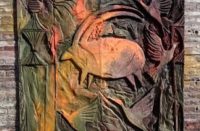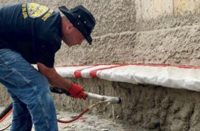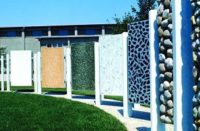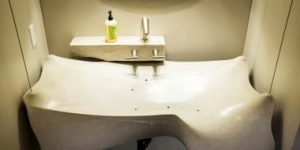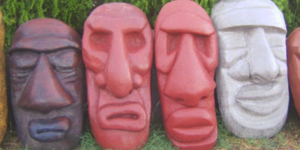Some things get better the second time around.
Take the Navy Corpsmen Memorial at Camp Pendleton in Oceanside, California, for instance. Back in 1983, Raul Avina, an Oceanside resident and local artist who as a young Marine was wounded in the Battle of Iwo Jima during World War II, completed a memorial for the Naval Hospital Camp Pendleton when he was in his 70s. It depicted three Naval corpsmen helping a wounded soldier down the side of a mountain to safety.


That memorial, whose likeness was subsequently incorporated into the hospital’s logo, took Avina two years to make in his garage using rebar, concrete and heavy mesh. It stood in front of the hospital for 31 years.
When the time came to replace the aging hospital with a new one, officials planned to relocate the iconic piece but soon discovered it would not survive the move. Some of the original pieces were salvaged and with the aid of photographs, renderings and the old memorial’s footprint — not to mention the rock-solid talent of a decorative concrete artisan — a new sculpture sprang to life. It was rededicated and unveiled Dec. 12, a year after the new hospital opened.
Mounting the challenges
Richard Winget, owner of Authentic Environments USA in Huntington Beach, California, was hired to create the 13 1/2-foot-tall rock for the memorial. Another artisan from Los Angeles was tasked with recasting the figures out of bronze instead of concrete. “Carving the rock around the bronzes proved difficult,” Winget says. “Not only were they hot, but reaching some areas was a real problem.”
In the process, he says, to make sure “the bronzes looked as if they were climbing down a mountain rather than just floating on it,” he and his crew had to move the figures in and out several times. “It was important to me that they look grounded and we went to great pains to make that happen,” he says. “That whole process was actually pretty involved.”
Winget built a small model on a 1-inch scale which he says proved useful in helping him figure out the steel schedule and work out any problems before construction began. For example, he says, “The mountain is a pyramid shape and as the steel began to rise in the air there was a problem with the steel becoming congested at the top. We solved this problem by eliminating bars the higher we got.”
Because they were in such close proximity to the ocean, they used specialty materials such as coated rebar and wire, plastic lath and plastic chicken wire. For the structure coat, he used specially designed shotcrete, and for the finish he used a product he makes and markets himself called Carve-Right. “The material had to meet engineered standards,” he says. “It was specified by engineers for this project, and I do mean engineers — as in more than one!”
One challenging part of the project was erecting the scaffold in such a way that they could reach everything. “It seemed like the memorial was constantly moving away from us the higher we got,” Winget says. They also had to make sure the scaffold was not in the way when the concrete was pneumatically applied.
One of the things that amazed Winget about this job was how many people were involved in this government-sanctioned project. “We had a safety inspector with us at all times and rigging experts on crane days. There were daily scaffolding inspections and general contractor supervisors watching every move we made,” he says, not to mention the Navy personnel and other people interested in what they were doing. “The lieutenant general had a privacy fence put up and we then screened our entire scaffold system so no one could see in!”
Protection was also vital to the success of the job, he notes, as they had to work around finished granite slabs and imported Jerusalem stone.
|
|
 |
Rock on
Work on the rock portion of the memorial began in October and ended in December. There were many delays due to weather and governmental red tape, Winget says. All told, the project took about eight weeks to complete with as many as five men working at a time.
Improvements to the replacement memorial included making the rock texture look more like that found on Mount Suribachi on the island of Iwo Jima. And unlike the original’s white finish, the new rock was colored with an array of topical colors and sealed with an ultraviolet protector to keep the colors from fading.
“We used all types of techniques and tools to bring realism to the rock,” says Winget, including brushes, knives and specialty trowels. He and his crew, which includes his son, Jacob, also made skins from stones that had been imported from Jerusalem for part of the new hospital’s facade and used them in combination with their carving process.
“Carving is nothing more than waiting for the right window of opportunity to make the material behave how you want it to,” Winget says. “Cracking and breaking is done late in the game, while deep splits are done early while the material is still wet.”
 |
 |
This is Winget’s first memorial but it will not be his last. “I have plans to do another one in New Jersey to mark the 9-11 disaster,” he says.
As for this one, he says he was honored and flattered to be a part of this design/build project, especially when Dan Avina, son of Raul, who passed away in 2003, shook his hand after the dedication ceremony and thanked him for his fine work. “I wanted his approval,” Winget says, explaining that the new memorial includes the original nameplate. “We don’t get credit; the original artist does. And that’s OK. I just feel privileged to do something for the men and women in the military who have given so much for our country.”
www.carve-right.com
www.authenticenvironments.com
Project at a Glance
Client: U.S. Navy
General contractor: Clark Construction Group/McCarthy Building Cos. www.clarkconstruction.com
www.mccarthy.com
Contractor: Authentic Environments USA in Huntington Beach, California | www.authenticenvironments.com
Scope of project: To recreate and improve the Navy Corpsmen Memorial built in 1983.
Most challenging aspect: Positioning and repositioning the bronze statues during the rock-carving process
Products used: Shotcrete from local ready-mix plant for structural coat; Carve-Right, a preblended sculptural concrete from Carve-Right Inc., for the finish texture; epoxy-coated rebar from R.R. Leonard Co.; Benjamin Moore’s Masada, Modern Masters’ Raw Umber, Glidden’s Traditional Tan and Butterfield topical colorants; L. M. Scofield Cementone Clear Concrete Sealer; and plastic chicken wire, plastic lath and plastic-coated tie wire
